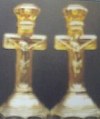Carnival Glass 101 | home Quick Reference to Carnival Glass Patterns on This Site
Dugan - Part 4
DUGAN - Part 4
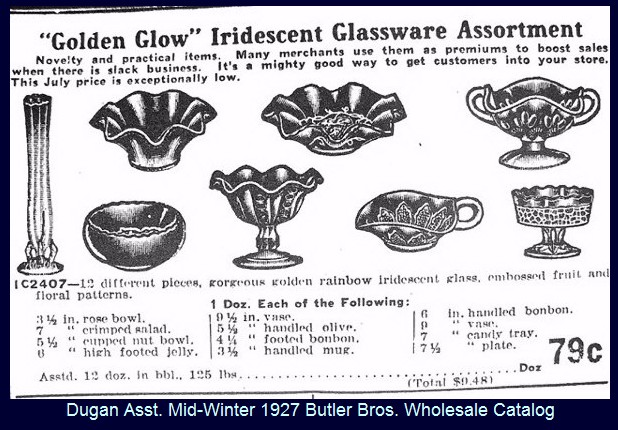
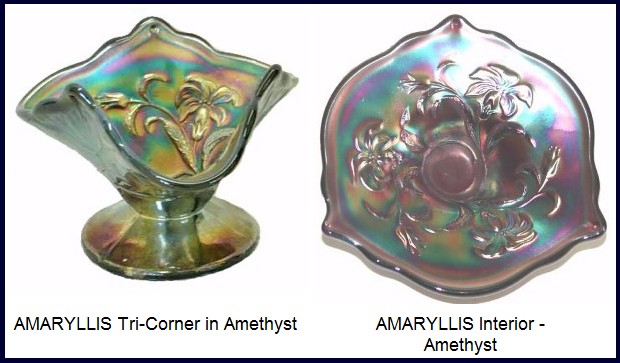
AMARYLLIS: Since this neat little compote is found in rare blue and white examples, the design was probably in production around 1912. The general shape is triangular, and when a compote is found very tightly ruffled, those angles can be tucked in quite tightly. The compote stands close to three inches tall. Ruffled examples are the customary shape, with an occasional deep, round shape. White is very difficult to locate, with only a few blue examples known. Marigold is the usual color found in ruffled shape, but we owned a beautiful flat plate shape in marigold at one time. These whimsey plates are quite rare in any color, but amethyst and white examples are known as well as the marigold. Spectacular amethyst plates will command some serious prices! The exterior design is called Poppy Wreath, a carry-over from non-iridescent production. It appears in the 1907 Dugan factory catalog.
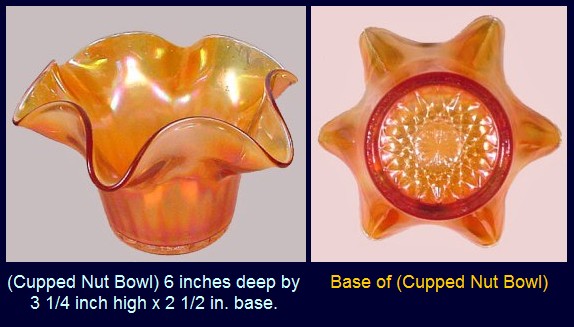
CUPPED NUT BOWL: For lack of a better name, we call your attention to one such as this in the accompanying 1927 catalog ad. Simply and plainly designed, with many collectors not giving it much notice, we hasten to state that dozens of auctions come and go without this piece! If it is rare which you require, this would seem to answer the purpose. Either few of them sold when manufactured, or they became utilitarian, with breakage taking a tremendous toll. How many have you seen in the search for your latest-favorite piece?? Are marigold examples the extent of the color line?
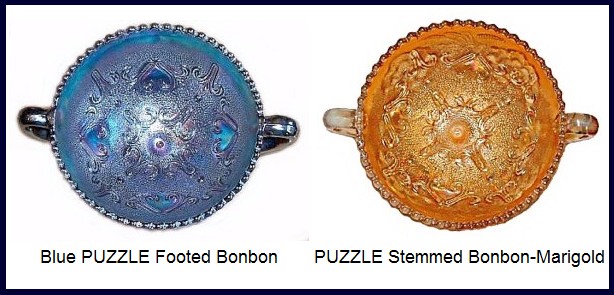
PUZZLE: Used as a primary pattern found on the interior of stemmed, two-handled bonbons, with Floral and Wheat as the exterior pattern. These can be round, ruffled or card tray shaped (two-sides pulled up). Marigold, peach opalescent and white are the most oft-found colors. Amethyst examples are more difficult, with cobalt blue bonbons quite rare indeed. With non-iridized celeste blue examples known, there is a strong possibility that some iridized bonbons will turn up.
Puzzle pattern had a long production run from around 1910-1911, continuing to appear in wholesale catalogs into 1916. Diamond Glass extended production when introducing its Cerulean blue, or Celeste blue in 1916.
Floral & Wheat exterior pattern on the Puzzle bonbon is a Diamond Glass Pattern.
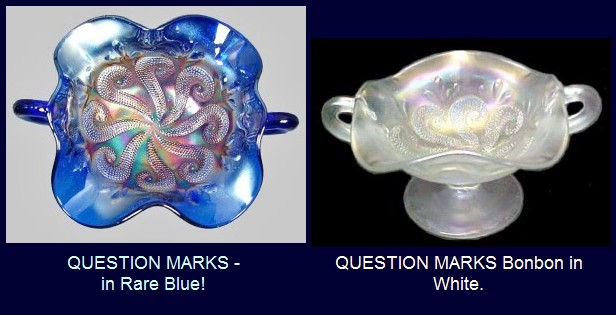
QUESTION MARKS: Although this pattern does not appear in known issues of wholesale catalogs before the early 1920s, research leads to earlier Dugan production around 1910. Peach opal and white were colors introduced by Thomas Dugan, and this pattern is found frequently in both those colors. Since the pattern appeared in wholesale catalogs with regularity until the plant closed in 1931, it deserves a production longevity award! The two-handled, stemmed bonbon is found in marigold, amethyst, white, cobalt blue, peach opalescent, ice green, smoky/lavender, and lime green w/marigold overlay. Green has been reported but unconfirmed.
Puzzle is also found as a secondary pattern on the pedestal foot of compotes and stemmed plates in the Question Marks and Georgia Belle patterns. Compotes combining the three patterns are found in marigold, amethyst, white and peach opalescent. Stemmed plates: marigold, amethyst and white.
The Georgia Belle design is a carry-over from Dugan’s Intaglio line, made just prior to the carnival glass era. Comprised of impressed peaches and leaves, it is most attractive when found on the exterior surface of a Question Marks stemmed plate.
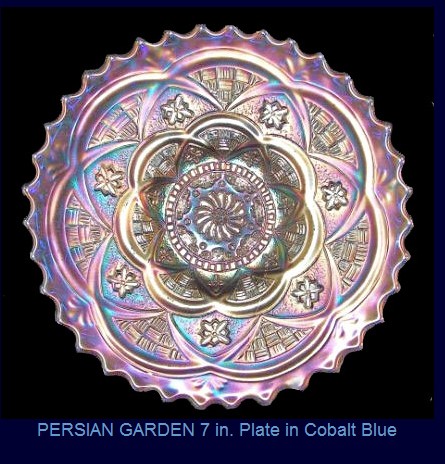
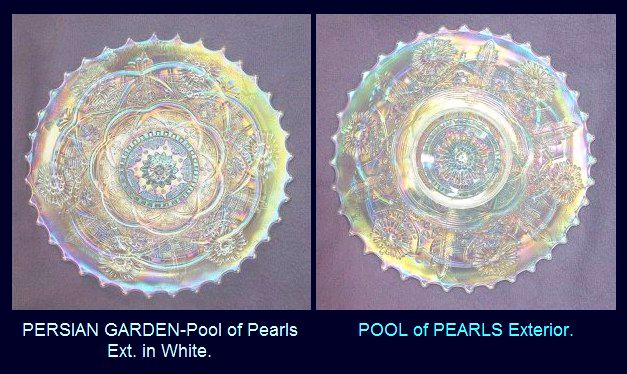
PERSIAN GARDEN: Not many of the blue plates in this pattern are known. We thought you would enjoy seeing the intensity of color displayed on this example.
The white 6”-7” plates in this pattern can either offer a plain exterior or the Pool of Pearls pattern shown here.
1910-1911 is a likely introduction period for this intricate pattern, with production extending into the Diamond years through mid 1915. The unusual abundance of white examples in all shapes found in this pattern indicates that the moulds were among those which survived the 1912 fire. Dugan and Diamond achieved a lot of mileage from the moulds! There are eight known shapes and seven of them were produced from the same two moulds.
A lovely and rare amethyst small plate can be viewed by clicking on ~~ ~~ in our pattern alphabet on the homepage.
~~ in our pattern alphabet on the homepage.
Dean & Diane Fry – 7/07
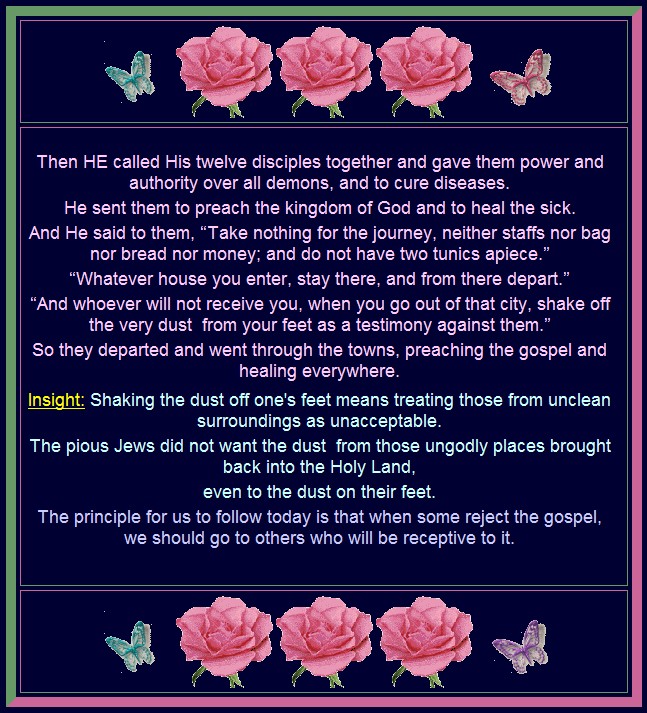
Should you care to contact the Frys, their email address is:
Search Our Sites
back to Carnival Glass 101
Our other sites you may enjoy:
Everything you EVER wanted to know about Indiana Glass
Great Reference for Newer Carnival Glass.
Complete Glassware Catalogs Available to Download
Questions? Comments? Suggestions? Broken Links? Corrections?
Your Friendly Webmaster is here to help!
